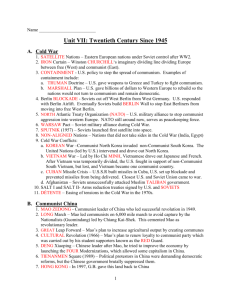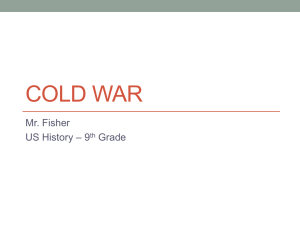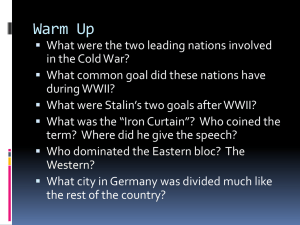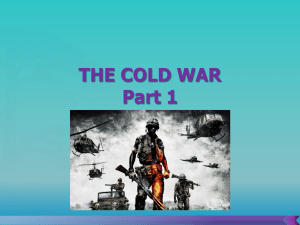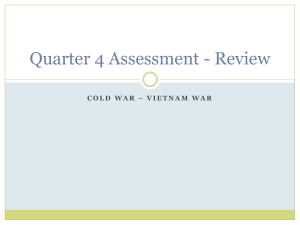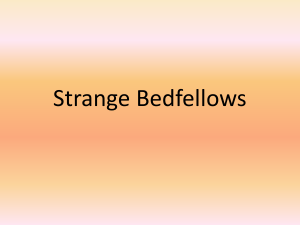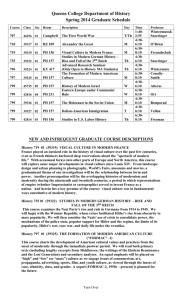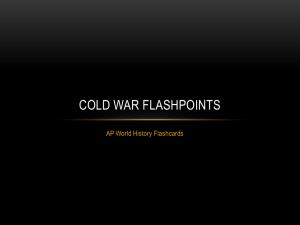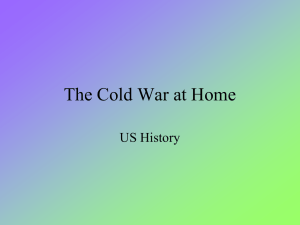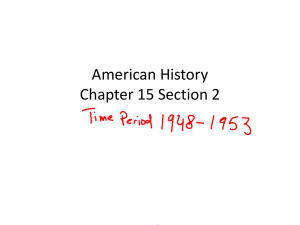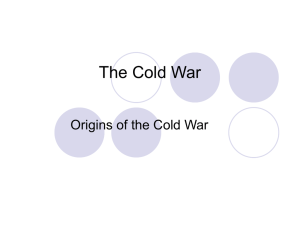The Cold War - Killarney Secondary School
advertisement
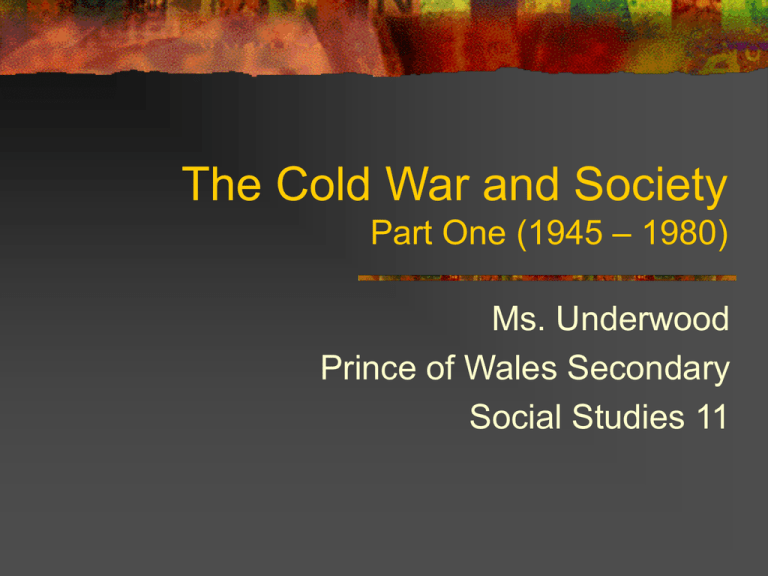
The Cold War and Society Part One (1945 – 1980) Ms. Underwood Prince of Wales Secondary Social Studies 11 Time for Peace… The League of Nations had failed to keep the peace after WW 1. Had no military power. Most influential members were not committed. After WW2, there was a need for a new organization to keep the peace. In 1945 the UN formed The United Nations 50 countries met in San Francisco (including Canada). Had four goals: 1. 2. 3. 4. Keeping world peace and preventing new wars. Encouraging cooperation among nations. Defending human rights and helping to promote equality. Improving the standard of living for all nations. Canada and the UN Played a key role in the drafting of the UN Charter. In 1948, Canada received its own seat on the Security Council. There are 5 permanent seats (Russia, US, Britain, France, China). Canada has a non-permanent seat. Active in peacekeeping efforts. Start of a different kind of war… The Cold War, a struggle of ideologies between the world’s two new super powers: US and Russia. Fought using propaganda, espionage, and economic and political pressures. The two countries did not fight in direct combat. It was a fight for power and influence on a global scale. Characteristics of the Cold War Continual fear of a nuclear war. Arms race. Differing viewpoints on acceptable social, political, and economic philosophies. Democracy vs. Authoritarianism Capitalism vs. Communism Fear of the spread of communism (Western perspective). Ideological Differences Western capitalist nations feared the part of communist ideology that was aimed at world revolution. The Soviet Union feared being surrounded by capitalist countries (possible counterrevolution). The Domino Theory The US was concerned with the way that Stalin was able to quickly establish communist regimes in 6 countries after WW2. The Domino Theory implied that the rest of the countries in Europe would soon fall one by one to the Soviets. Satellite States The 6 countries that became communist under the Soviets were completely controlled by the Soviet Union. (Satellite States). Winston Churchill declared that an Iron Curtain had fallen across Europe that divided communist and non-communist states. Containment In 1947 US declared the Truman Doctrine – to support free people around the world who were resisting subjugation (esp. people threatened by communism). The policy of containment meant to halt or stop the spread of communism, by providing economic aid a military support. The Marshall Plan offered billions of dollars in aid to war-torn European economies to help them resist communism. Canadian Concerns Igor Gouzenko asked for political assylum in Canada in return for giving the Cdn. Government documents that proved there were two spy rings in Canada. The Red Scare: RCMP carried out inquires and investigations regarding potential communists in Canada. Potential immigrants were denied entry. Known communists were deported. What about Germany? Had been divided after WW2 into 4 zones controlled by the US, Britain, France and Russia. US, Britain, and France joined their sectors together to form West Germany. Stalin created the German Democratic Republic, later to be called East Germany. A wall was built between the two sides. NATO Creation prompted by the Berlin Blockade. Soviet Union blocked transportation routes after a new currency was introduced in West Germany. NATO formed in 1949 to provide mutual defence between member countries. The Warsaw Pact was developed in response to NATO in 1955. NORAD Created in 1957. Radar stations were set up to detect Soviet Planes or missiles. Three radar lines were constructed in Canada’s North to provide advance warning of a missile attack. The DEW line, Mid-Canada line, and the Pinetree Line. Korean War 1950-53 After WW2 Korea was divided between the North and the South. The North became communist and the South, democratic. North Korea invaded South Korea, and would not leave. The US backed South Korea. 26,500 Canadians were sent with UN Forces. The Suez Crisis - 1956 Egyptian President Nasser seized the Suez Canal from Britain and France, who in response, joined with Israel to attack Egypt. The Soviet Union sided with Egypt. Lester B. Pearson suggested the UN intervene until an agreement could be sorted out. Won the Nobel Peace Prize in 1957. John Fitzgerald Kennedy While driving down a street in Dallas, Texas, the American President was shot to death (November 22, 1963). Allowed Cuban exiles to invade their homeland in an attempt to overthrow Fidel Castro. (Bay of Pigs) Was the President during the Cuban Missile Crisis. The Vietnam War, 1954-1975 Vietnam was divided between the North (Communist government, led by Ho Chi Minh) and the South (anti-Communist and partially democratic). The Americans supported the South. The Americans were trying to contain communism in South East Asia because they believed that the domino theory would be set into effect if South Vietnam fell to the Communists. The Vietnam War The Americans were having difficulties winning the war and lost a lot of public support. The US had a lot of troops in Vietnam. TV images appeared daily on TV of the widespread suffering of Vietnamese. Some people did anything they could to avoid being drafted, including heading to Canada where they evaded the military. These people were called draft dodgers. Cyprus, 1964-1993 A civil war broke out between the Greek majority and the Turkish minority. Canadian troops were sent when the conflict first broke out in 1964, and the last were not withdrawn until 1993. Canada spent almost $600 million to maintain its forces. Communist China is Recognized In 1949, Mao Zedong took over the government of China. The UN (pressured by the US) refused to recognize the communist government. Some countries (including Can.) recognized the communist government as the official government of China. By 1971, the Americans finally allowed Red China to have a seat on the UN Security Council. Problems in the Middle East Yom Kippur War, 1973. Egypt would eventually recognize Israel’s right to exist, and the Israeli’s agreed to negotiate the occupied territories. In the 1990s it seemed as though an agreement was finally at hand. However, the present Intifada (Palestinian uprising), which started in 2001, ended any hope for a resolution to the Arab-Israeli conflict. Afghanistan, 1979 Soviet Union invaded Afghanistan frustrated the West. Boycott of 1980 Olympic Games in Moscow. Soviets responded by boycotting the 1984 L.A. games. Soviets invaded Afghanistan to get closer to the oil reserves in the area. Arms Race Renewed Soviets deployed medium-ranged missiles to Eastern Europe. NATO responded by deploying more new advanced missiles in Europe. Disarmament talks halted (SALT 2 was supposed to limit the construction and deployment of ICBMs). In 1981, the US decided to spend mega $$ on Defence systems (modernization of nuclear weapons). Soviets attempted to again match weapons levels. Trudeau’s Foreign Policy In 1968, Pierre Elliott Trudeau was elected Prime Minister. One of his goals was to develop foreign policy that was less dependant on US approval. He wanted to scale back Canada’s participation in the nuclear arms race. He cut the National Defence budget and reduced Canada’s NATO contingent to half it’s size. He wanted to maintain good relations with the US. Social Welfare in Canada and Overseas Social Security- The Unemployment Insurance Act was passed in 1940 Government accepts social security as a responsibility. The Colombo Plan- Foreign aid initiative, built infrastructure in (commonwealth countries). La Francophonie- Canada joined this organization. Gave development aid to West Africa (developed to act as a link between French colonies). Social Changes in Canada Baby Boomers – Soldiers returning home were reunited with families. Canada’s population increased from 12 million in 1946 to 18 million in 1961. Immigration Policy – After the war, displaced persons from Europe arrived in Canada. Immigration Act of 1952 gave power the Minister of Immigration. Barring immigrants entry would continue. Demand for immigrant labour would open Canada for immigration. Immigration continued… The Citizenship Act of 1976 – Eliminated gender discrimination. Citizenship granted to children of overseas marriages when the mother was Canadian (used to be only granted when the father was Canadian). The Immigration Act of 1978 – Reduced barriers to immigration. 3 categories: Family, Refugee, and Independents. More Social Changes Entertainment – Watching TV and listening to Music! CBC bought American programs like “The Ed Sullivan Show”. Hockey Night in Canada was popular. Rock ‘n’ Roll… Beatles, Elvis, Rolling Stones. CRTC created to ensure that a certain percentage of the media was of Canadian origin. Protest Era Protesting – Teen culture developed that didn’t trust anyone over 30. A counterculture developed against the “Establishment” Protest over Aboriginal and black North American rights. Demonstrations against nuclear arms, American interference, and the Vietnam War. The Women’s Movement Demand for improved rights for women occurred. Women’s Liberation movement became popular in the 1960s. Sought changes in: Employment practices. Life choices. Politics. Women were looking to be treated equal in all fields. Expo ‘67 The Worlds’ Fair was held in Montreal. This was also Canada’s 100th birthday. Many world leaders came (Kings, princesses, presidents). French president, during a speech, shouted to the crowd “Vive le Quebec! Vive Quebec libre! Tensions between French and English heightened. Trudeaumania Being French-Canadian, many felt that he would finally address Quebec’s concerns. People were attracted to him because of his youthfulness, casualness, and style. Drove fast cars and was an outdoorsmen. Cool under pressure and was scholarly. Had wit and confidence. He was very popular, people swarmed around him. Women loved him. The Avro Arrow The RCAF wanted a supersonic long range jet to be developed. The contract went to A.V. Roe Canada. Cost estimated to be $2 million per plane. Could travel at Mach 1.5 Reached nearly $4 million per plane. Fearing soaring costs, Canadian government ceased production. The 6 completed planes along with reports and blueprints were torched. OPEC Crisis Organization of Petroleum Exporting Countries realized that the demand for oil was greater that the supply in 1972. OPEC raised the price of oil from $6 to $16 US a barrel. In 1979, war between Iraq and Iran caused a drop in the supply of oil and prices rose to $40 US. The National Energy Program In response to the OPEC crisis, Trudeau implemented the NEP, which would freeze Alberta oil prices below world levels to keep the price down for Canadians. Trudeau also put a tariff on oil sold to the US This angered Albertans as they were prevented from getting fair market value. Feelings of Western alienation grew… separation from Canada? Foreign Investment Review Agency FIRA was established to approve the establishment of any new foreign companies in Canada. Intended to target American investment. This was an attempt to protect Canadian industries. Canada as a Middle Power The world was divided between the West (US & allies) and the East (communist China, the Soviet Union et. al). The Trudeau government attempted to improve relations between the two sides by promoting peace. Attempted to reduce nuclear arms. Established trade and sporting links. It’s not over yet… By the end of the 1970s, there was no clear indication that the Cold War was ending. There would be more conflict throughout the 1980s.
